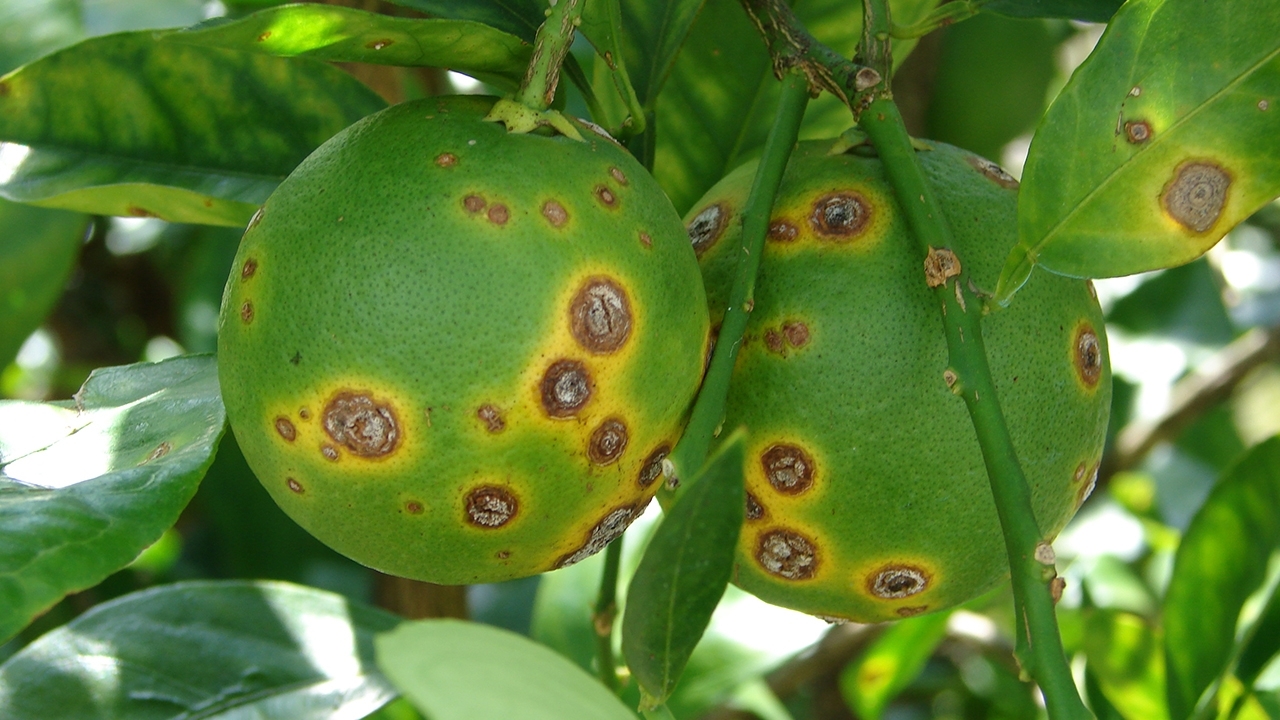Citrus Canker

Citrus canker is a disease caused by the bacterium Xanthomonas citri subsp. citri (synonym X. axonopodis pv. citri). It thrives in areas with high rainfall and warm temperatures. Citrus canker is found throughout Florida and in limited areas of Alabama, Louisiana, and Texas. Severely infected citrus trees may lose their leaves and prematurely drop fruit. Canker-infected fruit is safe to eat but is not marketable due to its appearance.
The bacteria that cause canker can enter tree leaves naturally or through wounds caused by weather or insects, such as the citrus leaf miner (Phyllocnistis citrella Stainton). It can survive for months on plant surfaces. Young leaves, stems, and developing fruit are most susceptible to the disease. The disease is spread by wind and rain and by people moving contaminated equipment, untreated infected fruit, and infected plants and clippings.
- Raised brown lesions with water-soaked edges and a yellow halo on fruit, leaves, or stems
- Older lesions may lose the yellow halo and appear corky
View symptoms in our citrus canker photo gallery.
- Know the quarantines in your area.
- Buy only USDA-certified citrus plants.
- Don't move branches, green waste, dead trees, and other regulated items out of a quarantined area.
- Do not mail or transport home-grown citrus fruit or plants out of a quarantined area.
- Commercial nurseries must follow strict protocols for moving citrus nursery stock (227.22 KB) out of quarantined areas.
There is no treatment or cure for citrus canker. Infected trees continually decline and eventually stop producing fruit.
Report Signs of Citrus Disease
If you think you’ve seen signs of this disease or pest, immediately report your findings to a State Plant Health Director.
Controlling Citrus Canker
Citrus canker was first identified in the United States near the Florida-Georgia border in 1910. It took 21 years and the destruction of 257,745 grove trees and 3,093,110 nursery trees to eradicate the disease.
In 1995, canker was again discovered in Miami-Dade County, FL. Despite a 10-year effort to eradicate the disease, a series of unprecedented storms in 2004 and 2005 spread the disease to the point where eradication was no longer possible. The Secretary of Agriculture officially called an end to eradication efforts in 2006. He directed that work shift to containing the disease and establishing criteria under which fruit and nursery stock could safely move out of Florida.
Citrus canker was later found in Louisiana in 2013, in Texas in 2016, and in Alabama in 2021. APHIS is working with partners to contain the disease in these States.
APHIS publishes the legal description of current quarantine areas. Users can search by State and pest to determine quarantine area(s).
- Citrus Canker Federal Regulations (7 CFR 301.75)
- Conditions of Movement (Federal Orders)
- Citrus Canker Regulated Articles (159.03 KB)
- APHIS Domestic Treatment Manual
A potentially actionable suspect sample (PASS) is a regulatory sample1 from the environment or an APHIS-approved exclusionary facility2 where preliminary diagnostics indicate that Xanthomonas spp.*, a USDA-regulated pathogen, is present and must be confirmed by APHIS' Plant Pathogen Confirmatory Diagnostics Laboratory (PPCDL).
Samples Collected from a Non-Regulated Area
Any regulatory sample collected from a non-regulated area3 or APHIS-approved exclusionary facility that tests positive using APHIS-approved tests for the presence of Xanthomonas spp., the causative agent for citrus canker, is considered a PASS and must be forwarded to PPCDL for final determination. A sample4 should consist of symptomatic plant material (leaves, twigs, or/and fruit).
Sample Diagnostics
USDA APHIS PPQ Science & Technology
Plant Pathogen Confirmatory Diagnostics Laboratory
9901 Powder Mill Rd. Bldg. 580
Laurel, MD 20708
Phone: 301-313-9208 or 301-313-9271
When forwarding materials, notify the lab by email (APHIS-PPQCPHSTBeltsvilleSampleDiagnostics@usda.gov). Include the number of samples, screening diagnostic results, and tracking information in this communication. Do not ship samples on Fridays or the day before a federal holiday.
Please see additional information for preparing and submitting samples.
Samples Collected from a Regulated Area
A regulatory sample collected in a regulated area5 where preliminary diagnostics indicate Xanthomonas spp. is considered a PASS and requires confirmation by PPCDL ONLY under the following conditions:
- The sample is an unusual detection (novel symptoms or new host), and/or
- The sample will result in the expansion of a previously established regulated area
If neither of these conditions apply, the sample should be evaluated by the State-designated laboratory or forwarded to the PPQ Domestic Identification Plant Pathology Lab for final determination.
PPQ Domestic Identification Plant Pathology Lab
USDA APHIS PPQ Kansas State University
4024 Throckmorton Plant Sciences Center
Manhattan, KS 66506
Phone: 785-532-1349
ppq.ops.ks.manhattan.lab@usda.gov
You must notify APHIS laboratories and the APHIS Domestic Diagnostics Coordinator (ppq.domestic.diagnostic.doordinator@usda.gov) of the suspect positive sample for which confirmation is being requested before shipping samples.
Definitions
1 Regulatory Sample: This is a sample of regulatory concern to APHIS for citrus black spot collected by regulatory officials.
(Return to content)
2 APHIS-approved exclusionary facility: A greenhouse structure designed to exclude quarantine pests that is approved by APHIS to produce citrus nursey stock for interstate movement.
(Return to content)
3 Non-Regulated Area: Any area where citrus canker is not known to occur in the United States.
(Return to content)
4 Sample: A sample refers to a single bag of leaves or a twig with attached leaves. Each sample is to contain 5 to 12 symptomatic leaves, if possible. We strongly recommend that each sample is from a single plant. Fruit or twigs without leaves could be collected if leaves are not available. In addition to the plant sample, an inactivated (boiled) bacterial streaming suspension prepared according to the WI-B-T-2-2 can be submitted.
(Return to content)
5 Regulated Area: Any APHIS-recognized area where citrus canker has been federally confirmed.
(Return to content)
*Xanthomonas spp. refers to 1) Xanthomonas axonopodis pv. citri (Xac A, A* and AW) with synonyms X. citri pv. citri, or X. citri subsp. citri or X. campestris pv. citri or X. smithii subsp.citri and 2) X. axonopodis pv. aurantifolii (Xac B & C) with a synonym X. fuscans subsp. aurantifolii.

